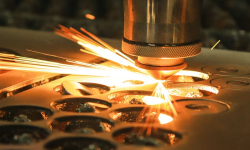
Introduction
In today’s manufacturing landscape, precision, speed, and cost-efficiency are non-negotiable. That’s where industrial laser cutting machines come into play. But before you dive into this high-tech investment, one crucial question needs answering — what’s the return on investment (ROI)? If you’re a business owner or production manager, this article is your roadmap to understanding how to calculate ROI and make a smart decision.
Understanding ROI (Return on Investment)
What Is ROI?
ROI is a performance measure used to evaluate the profitability of an investment. It tells you how much return you’re getting for every dollar (or rupee) you spend.
The Formula:
ROI=(Net ProfitInvestment Cost)×100\text{ROI} = \left( \frac{\text{Net Profit}}{\text{Investment Cost}} \right) \times 100ROI=(Investment CostNet Profit)×100
For example, if your net profit from the machine over one year is $50,000 and the total cost was $100,000:ROI=(50,000100,000)×100=50%\text{ROI} = \left( \frac{50,000}{100,000} \right) \times 100 = 50\%ROI=(100,00050,000)×100=50%
The Basics of Industrial Laser Cutting Machines

What Are They?
These machines use a high-powered laser beam to cut materials with extreme precision. They’re used in industries like automotive, aerospace, construction, signage, and more.
Types of Laser Machines
- CO₂ Lasers – Good for non-metals and thicker materials
- Fiber Lasers – Great for metals, high speed, low maintenance
- Nd:YAG Lasers – Used in specific high-power applications
Applications
- Metal sheet cutting
- Automotive parts
- Medical devices
- Signage and electronics
Initial Investment Cost
Here’s what your upfront cost typically includes:
- Machine Purchase: $50,000 – $500,000 depending on capacity
- Installation and Setup: $5,000 – $20,000
- Training: $2,000 – $10,000
- Facility Upgrades: Electrical setup, ventilation, safety gear
Total Initial Investment: Could range between $75,000 to $600,000
⚙️ Operating Costs
Power Consumption
Laser machines require high-voltage power but fiber lasers are energy-efficient.
Maintenance
Yearly servicing, spare parts, and calibration = $5,000 to $15,000 annually.
Skilled Labor
Operators and programmers – wages, insurance, and upskilling costs.
Revenue Generation Opportunities
- Higher Output: Faster production means more jobs completed.
- New Business: Offer cutting services to other businesses.
- Customization: Serve niche markets like art installations, medical, or jewelry.
⚖️ Comparing Traditional vs. Laser Cutting
Manual vs. Laser
- Manual: slower, less accurate, higher labor costs.
- Laser: fast, programmable, high repeatability.
Cost Per Part
Laser cutting reduces per-part cost due to faster processing and less rework.
Productivity and Efficiency Gains
- Cycle Time Reduction: Some processes see 50% time savings.
- Automation: Load/unload systems and robotic arms can be added.
- Software Integration: CAD/CAM optimization boosts throughput.
♻️ Material Utilization and Waste Reduction
Laser systems use nesting software that arranges parts to use the least material possible. That means less scrap, which equals more savings.
Time to ROI: Payback Period
Let’s break it down with an example:
- Total Cost: $150,000
- Monthly Revenue from Jobs: $15,000
- Monthly Costs (maintenance, power, labor): $5,000
- Net Monthly Profit: $10,000
Payback Period=150,00010,000=15 months\text{Payback Period} = \frac{150,000}{10,000} = 15 \text{ months}Payback Period=10,000150,000=15 months
Factors Affecting ROI
- Type of Material: Cutting metals yields higher margins than plastics.
- Volume: More jobs = faster ROI.
- Geographical Demand: High-demand areas see quicker returns.
Case Study: Fabrication Shop
A mid-sized fabrication shop invested $200,000 in a fiber laser machine.
- Monthly production increased by 4x
- Labor costs dropped by 30%
- Payback period achieved in 18 months
- Net ROI after 3 years = 120%
Tips to Maximize ROI
- Schedule preventive maintenance to avoid downtime.
- Upskill staff with regular training.
- Keep software updated for better cutting strategies.
- Use IoT monitoring to optimize operations.
⚠️ Common Pitfalls to Avoid
- Ignoring Hidden Costs: Freight, customs, insurance.
- Buying Bigger Than Needed: Know your volume.
- Neglecting Training: Poor operation can reduce output.
Future Trends and ROI Outlook
- AI & Automation: Machines that auto-adjust for material thickness.
- Green Tech: Lower power lasers for sustainable cutting.
- Cloud Monitoring: Real-time performance tracking boosts uptime.
Conclusion
Investing in an industrial laser cutting machine is a big step—but a potentially game-changing one. When calculated correctly, ROI can prove that the investment will not only pay for itself but also boost your business’s competitiveness, efficiency, and profits. Understand your needs, weigh your options, and you could be cutting your way to a better bottom line.
FAQs
1. How long does it take to get ROI on a laser cutting machine?
Typically 12–24 months depending on usage, efficiency, and market demand.
2. Are fiber lasers better than CO₂ for ROI?
Yes, they consume less power, require less maintenance, and work faster on metals.
3. Can I lease a laser cutting machine instead of buying?
Yes, leasing options can reduce upfront cost and improve short-term cash flow.
4. How do I calculate the per-part cost?
Add machine amortization, labor, maintenance, and power per job, then divide by parts produced.
5. Do I need skilled staff to operate the machine?
Yes, proper training is crucial for maximizing productivity and ROI.










